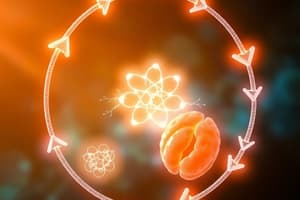Podcast
Questions and Answers
Which process provides more energy (ATP) from glucose than glycolysis?
Which process provides more energy (ATP) from glucose than glycolysis?
- Acetyl CoA production
- Cellular respiration (correct)
- Glycolysis
- Lipid metabolism
What is the change in Gibbs free energy ($\Delta G'$) for the full oxidation of glucose?
What is the change in Gibbs free energy ($\Delta G'$) for the full oxidation of glucose?
- -2,840 kJ/mol (correct)
- -2,994 kJ/mol
- -146 kJ/mol
- 6 CO2 + 6 H2O
What are the three major stages of cellular respiration?
What are the three major stages of cellular respiration?
- Acetyl CoA production, Glycolysis, Oxidative phosphorylation
- Acetyl CoA production, Citric Acid Cycle, Oxidative phosphorylation
- Glycolysis, Acetyl CoA production, Lipid metabolism
- Glycolysis, Citric Acid Cycle, Oxidative phosphorylation (correct)
What is the main function of the Citric Acid Cycle (CAC)?
What is the main function of the Citric Acid Cycle (CAC)?
What is the term for the reactions that replenish the intermediates of the Citric Acid Cycle?
What is the term for the reactions that replenish the intermediates of the Citric Acid Cycle?
Which molecule is produced for each acetyl CoA that enters the TCA cycle?
Which molecule is produced for each acetyl CoA that enters the TCA cycle?
What is the net change in Gibbs free energy ($\Delta G'$) for glycolysis?
What is the net change in Gibbs free energy ($\Delta G'$) for glycolysis?
Which process captures energy stored in lipids and amino acids?
Which process captures energy stored in lipids and amino acids?
What is the term for the reactions that replenish the intermediates of the Citric Acid Cycle?
What is the term for the reactions that replenish the intermediates of the Citric Acid Cycle?
What is the main function of the PDH (Pyruvate Dehydrogenase) enzyme?
What is the main function of the PDH (Pyruvate Dehydrogenase) enzyme?
Which process captures more energy (ATP) from glucose than glycolysis?
Which process captures more energy (ATP) from glucose than glycolysis?
What is the term for the reactions that replenish the intermediates of the Citric Acid Cycle?
What is the term for the reactions that replenish the intermediates of the Citric Acid Cycle?
What is the change in Gibbs free energy ($\Delta G'$) for the full oxidation of glucose?
What is the change in Gibbs free energy ($\Delta G'$) for the full oxidation of glucose?
What are the three major stages of cellular respiration?
What are the three major stages of cellular respiration?
What is the main function of the Citric Acid Cycle (CAC)?
What is the main function of the Citric Acid Cycle (CAC)?
Flashcards
Which yields more ATP: Glycolysis or Cellular Respiration?
Which yields more ATP: Glycolysis or Cellular Respiration?
Cellular respiration yields significantly more ATP from glucose compared to glycolysis alone.
ΔG' for glucose oxidation?
ΔG' for glucose oxidation?
The full oxidation of glucose has a Gibbs free energy change of -2,840 kJ/mol.
Three stages of cellular respiration?
Three stages of cellular respiration?
The three stages are Glycolysis, the Citric Acid Cycle, and Oxidative Phosphorylation.
Main function of the Citric Acid Cycle?
Main function of the Citric Acid Cycle?
Signup and view all the flashcards
Anaplerotic reactions?
Anaplerotic reactions?
Signup and view all the flashcards
CO2 produced per acetyl CoA?
CO2 produced per acetyl CoA?
Signup and view all the flashcards
ΔG' for glycolysis?
ΔG' for glycolysis?
Signup and view all the flashcards
Captures energy from lipids/amino acids?
Captures energy from lipids/amino acids?
Signup and view all the flashcards
Main function of PDH enzyme?
Main function of PDH enzyme?
Signup and view all the flashcards
Study Notes
Cellular Respiration
- Cellular respiration process that provides more energy (ATP) from glucose than glycolysis is the oxidative phosphorylation.
Thermodynamics
- The change in Gibbs free energy ($\Delta G'$) for the full oxidation of glucose is -2870 kJ/mol.
Stages of Cellular Respiration
- The three major stages of cellular respiration are glycolysis, the citric acid cycle, and oxidative phosphorylation.
Citric Acid Cycle (CAC)
- The main function of the Citric Acid Cycle (CAC) is to produce energy for the cell by generating ATP, NADH, and FADH2.
- The term for the reactions that replenish the intermediates of the Citric Acid Cycle is anaplerotic reactions.
- For each acetyl CoA that enters the TCA cycle, one molecule of CO2, three molecules of NADH, and one molecule of FADH2 are produced.
Glycolysis
- The net change in Gibbs free energy ($\Delta G'$) for glycolysis is -73.6 kJ/mol.
Energy from Lipids and Amino Acids
- The process that captures energy stored in lipids and amino acids is beta-oxidation and the citric acid cycle.
Pyruvate Dehydrogenase (PDH) Enzyme
- The main function of the PDH enzyme is to convert pyruvate into acetyl CoA, which then enters the citric acid cycle.
Studying That Suits You
Use AI to generate personalized quizzes and flashcards to suit your learning preferences.



